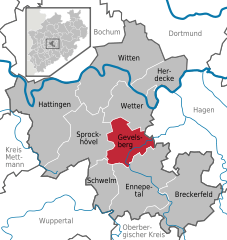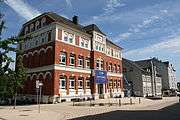Gevelsberg
| Gevelsberg | ||
|---|---|---|
|
Gevelsberg in summer | ||
| ||
 Gevelsberg | ||
Location of Gevelsberg within Ennepe-Ruhr-Kreis district 
 | ||
| Coordinates: 51°19′N 7°20′E / 51.317°N 7.333°ECoordinates: 51°19′N 7°20′E / 51.317°N 7.333°E | ||
| Country | Germany | |
| State | North Rhine-Westphalia | |
| Admin. region | Arnsberg | |
| District | Ennepe-Ruhr-Kreis | |
| Government | ||
| • Mayor | Claus Jacobi (SPD) | |
| Area | ||
| • Total | 26.27 km2 (10.14 sq mi) | |
| Elevation | 160 m (520 ft) | |
| Population (2015-12-31)[1] | ||
| • Total | 31,315 | |
| • Density | 1,200/km2 (3,100/sq mi) | |
| Time zone | CET/CEST (UTC+1/+2) | |
| Postal codes | 58285 | |
| Dialling codes | 0 23 32 | |
| Vehicle registration | EN | |
| Website | www.gevelsberg.de | |
Gevelsberg is a town in the district of Ennepe-Ruhr-Kreis, in North Rhine-Westphalia, Germany.
Geography
The town lies in the valley of the river Ennepe in the Süder Uplands, which is part of the Rhenish Massif. Gevelsberg lies about halfway between Wuppertal and Hagen, and is part of the industrial Ruhr Region. The lowest elevation is the Ennepe river at Vogelsang (132 m (433 ft)) and highest is the Hageböllinger Kopf (336 m (1,102 ft)). Its east-to-west length is 7.1 kilometres (4.4 miles) and the north to south length is 7.15 km (4.44 mi).
Division of the town
- Asbeck
- Berge
- Gevelsberg
- Silschede
History
The city has a history of nearly 780 years. The archbishop of Cologne Engelbert II of Berg was killed on November 7, 1225 by his cousin Frederick of Isenberg in Gievilberch.
The population grew strongly in the 19th century, when many small industries related to iron processing were developed.
Coat of arms
Gevelsberg received its coat of arms (a brick gable on a green hill, and a cogwheel indicating its industry) by decree of the Prussian Department of the Interior in 1903. In the mid-1950s a city wall was added to the coat of arms.



Transport
Gevelsberg is connected to the national road network by the A1 autobahn and the B 7 and B 234 roads.
The municipality is served by several regional train lines of the Verkehrsverbund Rhein-Ruhr. There are four stations on the local line from Hagen to Wuppertal (Gevelsberg-Knapp, Gevelsberg Hauptbahnhof, Gevelsberg-Kipp and Gevelsberg West) served by the S 8 trains of the Rhein-Ruhr S-Bahn. Three hourly Regional-Express services, the Wupper-Express (RE 4) between Dortmund and Aachen via Düsseldorf, the Rhein-Münsterland-Express (RE 7) between Krefeld and Münster via Cologne and Hamm and the Maas-Wupper-Express (RE 13) between Venlo (Netherlands) and Hamm via Mönchengladbach, stop at Ennepetal (Gevelsberg) station.
International relations
Gevelsberg is twinned with:[2]
 Vendôme, France[2]
Vendôme, France[2] Szprotawa, Poland, since May 17, 1996[2]
Szprotawa, Poland, since May 17, 1996[2] Butera, Italy, since May 8, 2004.[2] Some 1,000 people from Butera and Caltanisetta (Sicily) live in Gevelsberg.
Butera, Italy, since May 8, 2004.[2] Some 1,000 people from Butera and Caltanisetta (Sicily) live in Gevelsberg.
Festivities
- Gevelsberg Kirmes - held every last weekend of June
- Quellenfest - every year on Ascension Thursday to Sunday
Sons and daughters of the town
The following persons were born in Gevelsberg or live in Gevelsberg:
- Michael Cramer (born 1949), politician, (The Greens), member of the European Parliament
- Elisabeth Höngen (1906-1997), singer (Mezzosopran) at the Semperoper in Dresden, professor at the Vienna Music Academy
- Alexandra Popp (born 1991), soccer player (German women's football team)
- Klaus-Peter Thaler (born 1949), cyclist, multiple amateur and professional world champion
- Klaus Weiss (1942-2008), jazz drummer
- Lukas Klostermann (born 1996), soccer player (German U21 national football team, RB Leipzig)
External links
| Wikimedia Commons has media related to Gevelsberg. |
- www.gevelsberg.de (in German)
References
- Notes
- ↑ "Amtliche Bevölkerungszahlen". Landesbetrieb Information und Technik NRW (in German). 18 July 2016.
- 1 2 3 4 "List of Twin Towns in the Ruhr District" (PDF). © 2009 Twins2010.com. Retrieved 2009-10-28. External link in
|publisher=(help)

